
Disclaimer: this rocket architecture only shows what's theoretically possible and I may be off on some things. I would also like to add that any performance shortfalls is easy to fix, just increase the height of the propellant tanks a bit more.
Sources:
search for "SpaceX 2016 ITS presentation" and download the pdf "WHY MARS?" On slide 37 there is a Delta V chart showing TMI and landing delta V.
Rocket equation calculator: https://www.omnicalculator.com/physics/ideal-rocket-equation
I use 380s of isp for the vacuum Raptors and 355 for the sea level Raptors when they fire in vacuum.
I use a steel density of 8grams/cubic centimeter.
A regular rocket gets into orbit with enough fuel to get to its destination.
Starship gets into LEO with full payload and needs to be refilled to get anywhere.
This concept is even more extreme: it barely gets into orbit at all, arriving empty of both fuel and payload, maximizing dry mass instead!
The old 2016 ITS (Interplanetary Transport System) design had about 1500 m3 of internal volume and was capable of transporting 450t to Mars when it utilized on orbit cargo transfer. This results in a cargo density of 100t/333m3. Applying that density to Starship means we need to have a 9m cylinder 52.5m tall to fit 1000t of cargo.
The landing burn on Mars would need as much as 1.5km/s of delta V due to the high density of the fully loaded ship. That delta V plus the trans-Mars injection pushed the total delta V needed to 5.5km/s, this would need even bigger propellant tanks, instead, I have designed the ship to arrive empty at Mars and aerobrake into a low Mars orbit. It's then refilled by a tanker launched from Mars. This way the tanks of the ship only need to be sized for the 4km/s of delta V that the trans-Mars injection needs. Lastly the refilled ship lands on Mars.
The math:
I will calculate the mass of the cargo section and the nosecone as a 55m tall cylinder with a wall thickness of 4mm. 28.27 × 55 × 0.004 × 8 = 50t
The tank section is 50m tall and I will use a wall thickness of 5mm. 28.27 × 50 × 0.005 × 8 = 56.5t
I will use 8mm wall thickness for the skirt. 28.27 × 6.5 × 0.008 × 8 = 12t
The three bulkheads add about 12t.
6 Rvacs = 12t 3 Raptor = 4.5t Flaps = 15t
50 + 56.5 + 12 + 12 + 12 + 4.5 + 15 = 162t
Adding 15% Heat shield: 162/0.85 = 190.5t
The tank pressurization gases at 3bar and the air in the nose all add up to about 15t
190.5 + 15 = 205.5t
Now we have, 205.5t ship. 1000t payload. 2525t propellant. 377s average isp (6 vacuum and 1 ordinary Raptor firing)
Using the rocket equation we get 4168m/s of delta V which is more than enough to transfer to Mars and reserve some gases for the circularization burn after aerobraking into a nearly circular orbit.
One thing that surprised me was how efficient this architecture is. It uses only 18 launches: 1 launch of the ship. 5 launches of cargo. 12 launches of propellant. This equates to 1.8 Earth launches per 100t delivered to Mars. However, you also need to account for the Mars launches required to refill the ship, but exactly how many are needed?
The math 2:
The cargo ship needs about 600t of propellant in low Mars orbit to land.
If a regular Starship has a dry mass of 140t, 10t pressurization gases and 10t residuals (160t) it needs to weigh 210t on orbit to land back on Mars. I will use 4km/s of delta V needed to reach low Mars orbit. It turns out, with a ship launch mass of 2440t it arrives weighing 810t in Mars orbit and if we subtract the 210t (ship+ landing propellant) we get exactly the 600t propellant needed to refill the waiting ship for landing!
Efficiency calculation: 18 launches times 6500t stack mass = 117000t of rocket 117000t + One 2440t rocket = 119440t 119440t of rocket is required to get 1000t of cargo to Mars. 1000/119440=0.837% 0.837% of the launched mass is delivered to the surface of Mars!
Just to put things into perspective, it's not uncommon for rockets to deliver only 2% to low Earth orbit, so getting nearly one percent to Mars is insanely good!
Fun idea! One issue is the limiting factor for cargo per Starship to Mars is largely aerobraking on arrival.
The sims we have seen show Starship needing to pull a 5 g inverted aerobraking with the lift vector pointed at Mars just to stay in the atmosphere long enough to slow down.
Your stretched ship with 1000 tons of cargo has a much higher ballistic coefficient than a normal ship, making aerobraking much harder. To compensate, you would need to also increase the aerobraking cross section of the stretched Starship, which will increase dry mass and much of the gains evaporate.
You can do the same thought experiment with non stretched Starship. It has plenty of delta-v to leave LEO (or a high energy orbit) with a higher payload mass than it can aerobrake.